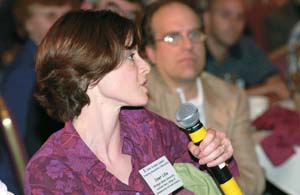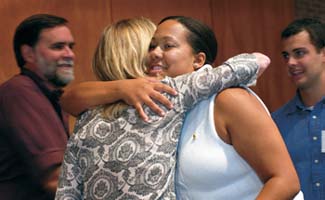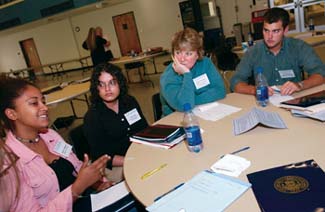 |
 |
| current issue |  |
past issues |  |
send a letter/news |  |
address update |  |
advertise |  |
about us |  |
alumni home |
Short Features
The Morning AfterPage 2 of 2
The trustees also authorized campus presidents to use part of student fee reserves retroactively to reimburse communities for their costs during and following student disturbances. On Jan. 17, the Alumni Association board of directors unanimously passed a resolution endorsing the administration's efforts.

|
UNH's Student Summit: Promoting Responsible Celebrations was the first national student-led initiative on the issue of student behavior. Students and administrators from UNH and nine universities spent more than two days in September talking about ways to shift student attitudes. The National Collegiate Athletic Association (NCAA), which released a study on post-game behavior last February, also sent a representative.
"What UNH did was precisely what needed to happen," says Daniel Wann, professor of psychology at Murray State University, and a national authority on celebratory behavior who was the summit's keynote speaker. "The one certain way to shift the culture of behavior is to build a critical mass, and in order to increase the number of people who want that shift, there needs to be a close examination of the problem. The summit started the process."
The summit brought together student leaders, administrators, law enforcement officials, student athletes, town officials, members of fraternities and sororities and students who had been a part of a riot elsewhere. With two UNH facilitators, assistant provost Jim Varn '76 and professor of communication Sheila McNamee, groups met to talk about their experiences with student disturbances.
Some of the common themes that emerged were predictable: significant alcohol consumption, strong police presence and the phenomenon of cell phones as a means to draw additional revelers. But less predictable themes surfaced as well: that police and administrators were just as afraid as the students; how the large crowd provided anonymity to students who threw beer bottles and rocks.

|
Insights shared during the discussions led to developing ideas to change things. The question posed by McNamee was a simple one: "Imagine that your campus is known for the most wonderful and engaging student celebration. What would it look like?"
Answers came from all corners of the room: "Nobody would get hurt, and there would be no property damage." "There would be a field with music, and dancing--neighbors with children, students, the elderly." "Everyone would wear shorts and half the town would be there."
Mark Rubinstein, vice president for student and academic services, recalls it became "a conversation of what we are heading toward, not what we're trying to get away from." For Rubinstein and other top administrators, it was important to emphasize a sustained approach to the prevention of disturbances.
By the closing session, the groups agreed that what will most likely stop future disturbances is a combination of peer pressure, more creative programming and stiffer penalties for students found responsible for unlawful behavior.

|
For UNH, those next steps include a Faculty Senate task force to study the possible links between student behavior and the university's expectations of student achievement. A group of students, working with staff, talked to fellow students on the consequences of large gatherings run amok. Others are working on student programming for weekends. And the dialog continues on an e-mail discussion list hosted by UNH.
McNamee and others are facilitating a series of "study circles" on alcohol use on campus. Faculty, students and staff meet in an informal setting on a weekly basis to talk about problems and solutions around the issue of high-risk drinking.
"The summit was a real turning point, especially for the students," says Cat Clarke '05, student body vice president. "We finally saw that there was light at the end of the tunnel. It will take a long time, but we will come out on the other side of this."
Page:< Prev 1 2Easy to print version
blog comments powered by Disqus

